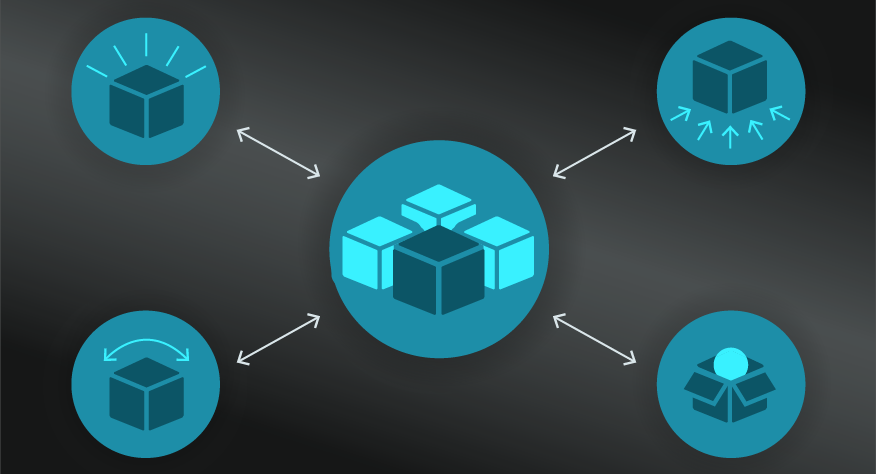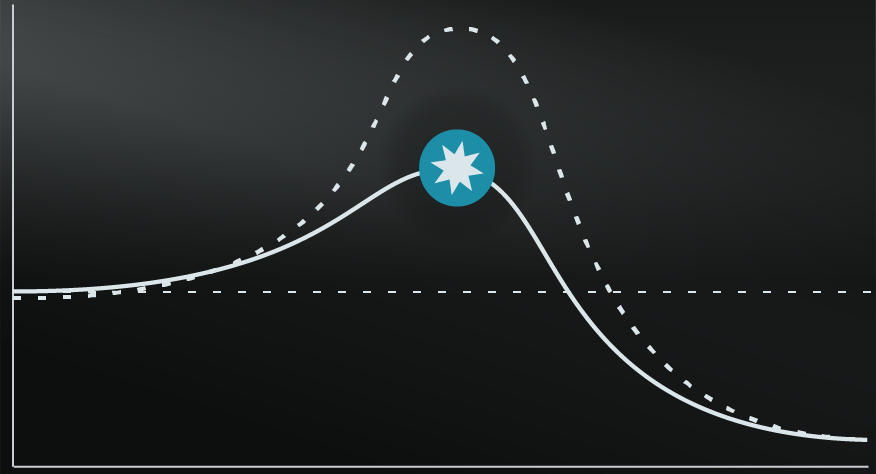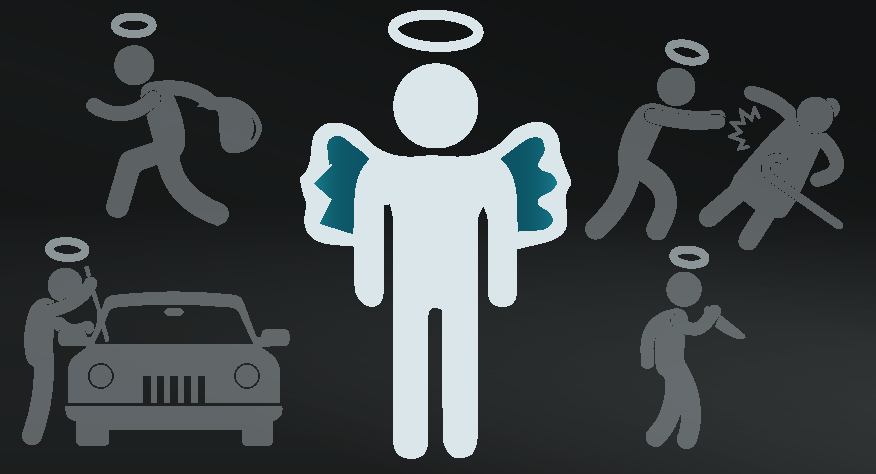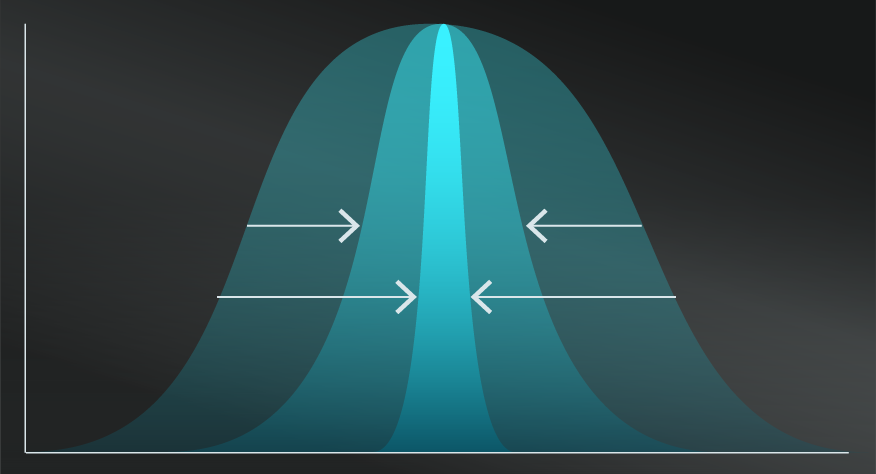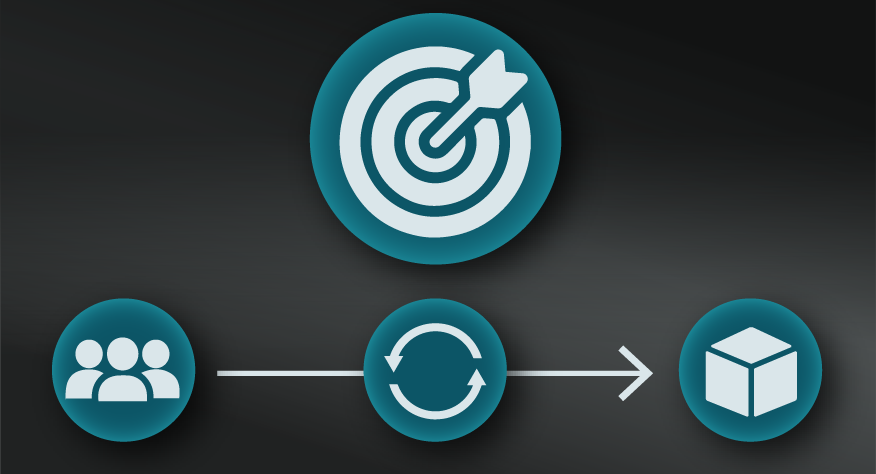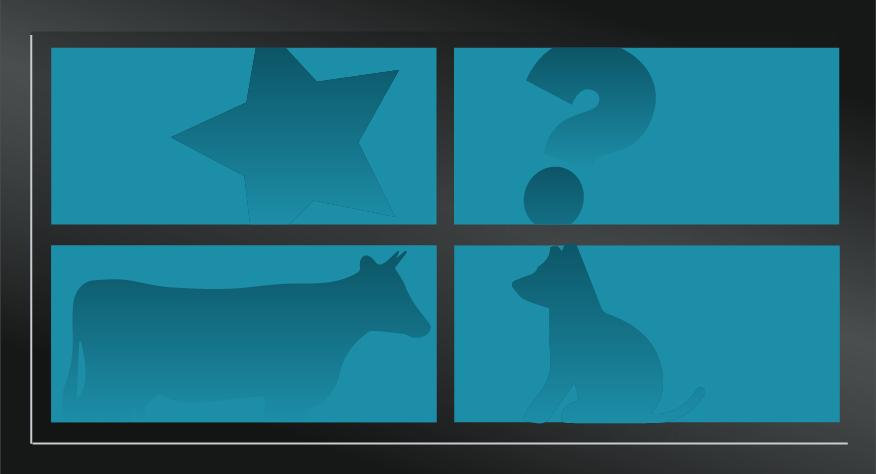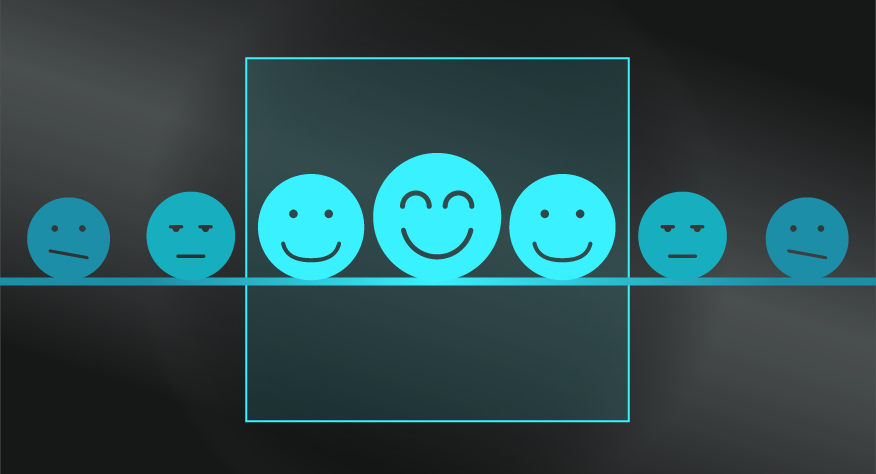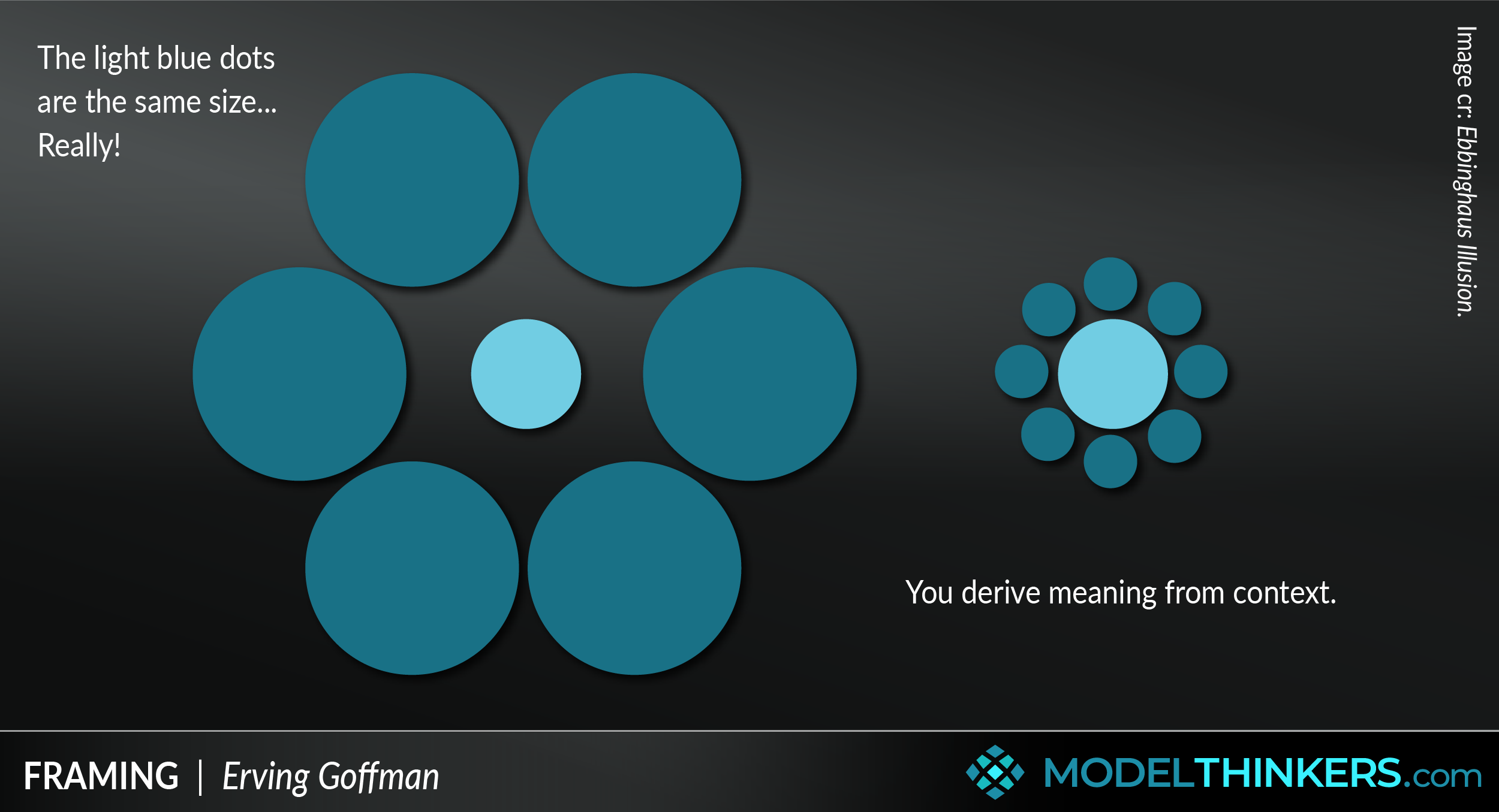
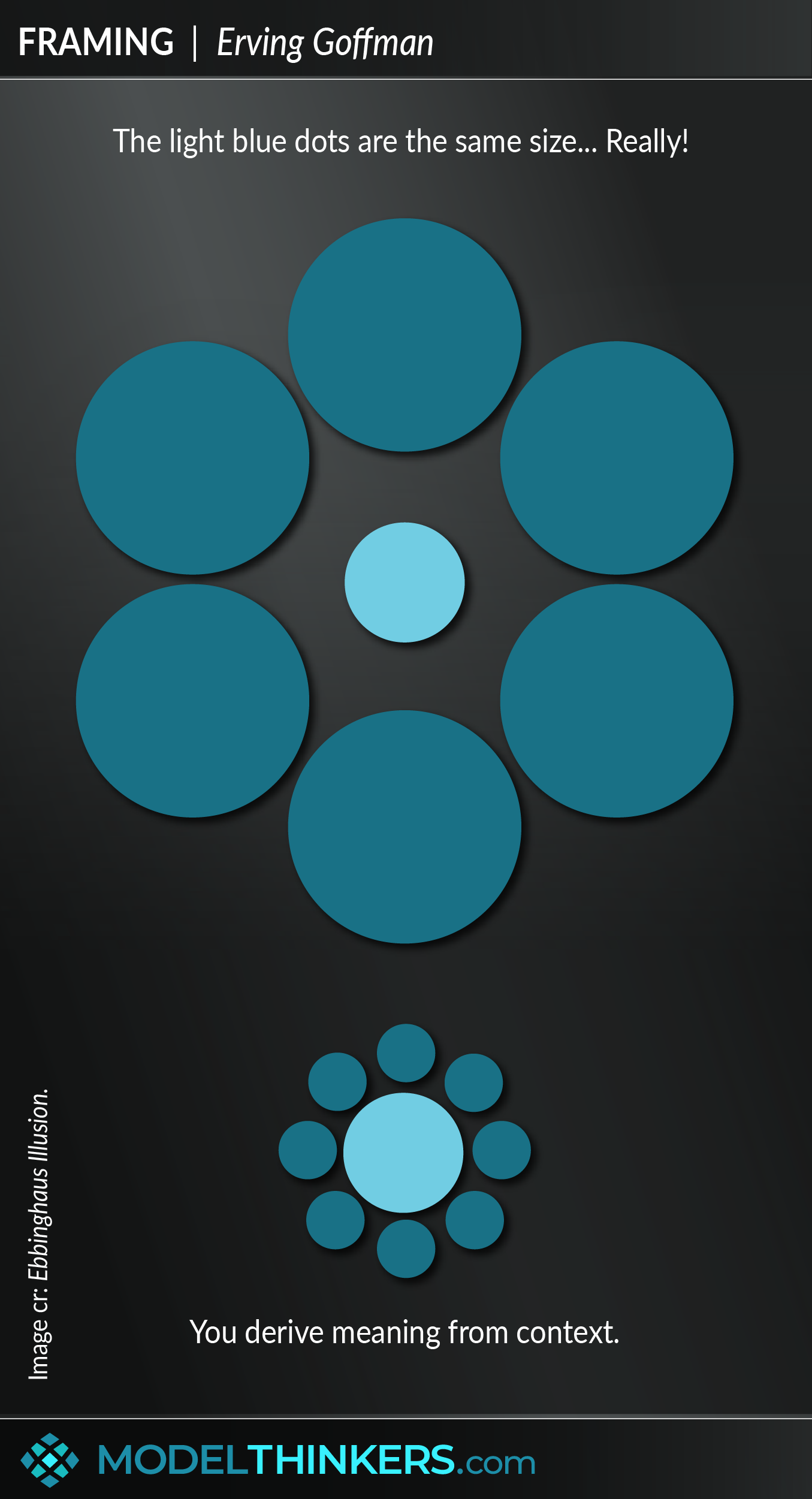
 0 saved
0 saved
 36.7K views
36.7K views








This model explains why you'll buy 80% lean meat but walk past 20% fat beef; how you can present the same facts differently to better influence people; and why one of those damn dots in the image above looks bigger than the other one, even when you know they're identical.
Framing explains how people process and judge information based on the context, or frame, it's presented through. It highlights how we derive meaning from context.
PERSONAL vs PRESENTED FRAMES.
Framing is based on the idea that any issue can be viewed from a variety of perspectives. Such views or frames are essentially the Mental Models we use to understand and act in a situation, born from our personal beliefs, experience, and context, but also by the way information is presented to us. In that sense, there are both prior personal frames that we use to interpret information and frames used to communicate information to us. See Limitations below for more on the interplay between the two.
WHY YOU SHOULD CARE?
Having a more conscious and deliberate approach to Framing is crucial for three reasons:
- Media, marketing, and political messaging are using Framing techniques on you every day: Being aware of these approaches will help you to interrupt the Framing Effect, or bias, to your judgment and decision-making.
- Craft highly influential messaging using Framing: Rather than just focusing on presenting information and facts, think about what sort of frame and context you're providing and how this will impact on your audience's reaction. Use the prompts below for specific techniques.
- Challenge your personal Framing to reinterpret experiences: Did you fail, or are you experimenting? Do you throw away money paying taxes, or contribute to schools, roads, and hospitals? Did you waste two years on a dead-end job, or learn about what was important to you? The examples are endless and are a reminder that reframing your experiences and outlook can improve your happiness and change your approach. Start today by habitually asking 'how else could I frame this?' and/or 'compared to what?'
OUR TOP TEN FRAMING PROMPTS.
So you're sold on having a deliberate approach to Framing but not sure where to start? There are a number of academic taxonomies about Framing, but we didn’t find them particularly practical. Instead, we created our own list of ten Framing prompts to help you better identify, challenge, and use this model.
|
Framing |
Example |
|
Visual. Provide a visual contrast or images to invoke ideas and interpretation. |
The images news outlets choose to support any news coverage will inform its interpretation. A more immediate example is the Ebbinghaus Illusion, which we’ve used to illustrate this model. It's a reminder that our visual judgment relies on context to determine size, just as our broader judgment relies on context to determine everything else. |
|
Positive vs Negative. Pose the positive to gain more buy-in — what's the 'glass half full' story and message? |
In the 'Asian disease problem', researchers Tversky and Kahneman described a fictional disease that was expected to kill 600 people. They offered a range of choices and found that people consistently chose the option where ‘200 lives were saved’ rather than ‘400 people died’. This was an example of what Kahneman called the Framing Effect, see In Practice for more on this. Another common example is how adverts will tend to focus on what you'll save rather than what you'll spend. |
|
Values. Appeal to deeply held views and beliefs. |
Opposing climate change has less support with people who have conservative political beliefs, however, studies have shown Framing climate change around the conservative value of purity – focusing on the integrity of drinking water and skies — has had greater resonance with conservatives. |
|
Metaphors. Leverage people's existing understanding and beliefs. |
In one study, researchers described crime as a ‘virus’ to one group and a ‘beast’ to another. The rest of the information was the same, the metaphor was the only difference. The group who were given the virus metaphor was more inclined to support social reform, and the group given the beast metaphor was more open to increased policing. |
|
Slogans. Use simple messaging to reframe complex situations. |
Apple's 'Think Different' campaign famously framed them as an eclectic, creative choice for smart people. De Beers' slogan of 'A Diamond is Forever' helped them reframe an expensive purchase as something with eternal value. And L'Oreal's 'Because You're Worth It' took a similar approach, reframing their purchase as a vote for self-worth and self-care. |
|
Contrast. Describe what something is not. |
Adverts do this when they say, 'you'd expect to pay x amount for this offer, but we're only charging y.' You might also see this in pitches or proposals, with an outline of what the cost of doing nothing is, or the next best option to the one you're presenting. |
|
Social proof. Show which way the herd is heading. |
Represent something in terms of how other similar people to your audience like it. For example, ‘most people in your situation will choose x’. Or simply marking something as ‘the popular choice’, including testimonials, or calling something ‘best selling’. This has links with Cialdini’s Six Principles of Persuasion and the EAST Framework. |
|
Spin. Change the way something is being interpreted. |
The unfortunate basis for political communication, spin involves actively reframing something. For example, the UK New Labour government reduced and reframed the 1990s coverage of their Foreign Secretary’s affair by releasing information that the previous Governor of Hong Kong was under investigation by MI6 — which was seen to be a 'bigger issue' than an affair. Other spin techniques include selectively presenting facts or going on the offensive and attacking something else. |
|
Stories. Providing emotional connection. |
Think about almost every breakthrough performer in 'Top Idol' competitions. They are more than their performance, they are their story — how they overcame tragedy, hardship, sickness, and adversity and the resulting message of hope encourages inspiration and support for them beyond their singing. |
|
Setting. Consider the backdrop to define expectations. |
In 2007 Joshua Bell, widely considered to be one of the world’s best violinists, put on a baseball cap and went busking near a Washington Metro station. More than 1,000 people passed him and only 7 stopped to listen. He made $52 (with $20 from one person). Seven years later he played at the same spot, which was announced beforehand, to a packed crowd. Another example is how people being held in pre-trial detention are more likely to accept a plea bargain when their case goes to trial because their Framing is jail rather than freedom. |
IN YOUR LATTICEWORK.
This model is closely linked to an understanding of Mental Models which are the substance of your frames. As such, it is also very relevant to the Map vs Territory.
Framing explains the politics of the Overton Window, feeds into Cialdini’s Six Principles of Persuasion and is fundamentally linked to Kahneman’s work around Fast and Slow Thinking and Behavioural Economics. Of all cognitive biases, Framing has most in common with the Anchoring Heuristic, though it is broader in its... well... framing ;).
Combine Framing with your understanding of the Confirmation Heuristic to appreciate how frames can become compelling once established; and Loss Aversion and Hyperbolic Discounting when designing effective frames. Finally, in terms of reframing — be sure to explore practical techniques with Framestorming.




-
Challenge the Framing presented to you and seek diverse sources.
Be aware that messages and information are framed, and that the context presented will have a huge impact on the way you think and act. Challenge Framing by considering other comparisons, contexts, and even language around the information. A simple way to do this is to seek out sources that have different points of view and agendas.
-
Use Framing to influence.
View the summary above for ideas on using visual, metaphorical, values, and other forms of Framing. Don't just communicate information, be aware of the context you are creating around it and the comparisons/ reference points your audience will rely on to make a judgement.
-
Reframe your perspective, ask 'compared to what?'
Explore Framestorming to help you reframe as habit. Ask yourself 'how might I reframe this?' and ‘compared to what?’ to help see information and challenges in other contexts and perspectives. So your friend has bought a brand new car and you suddenly hate your old car? Ask, 'I don't like my car, compared to what?' Maybe the frame of comparison could be walking or catching the bus rather than your friend's new car.
The main limitation of Framing is the moderating effect of individual values and pre-existing beliefs. For example, studies by Paul Brewer in 2001 demonstrated that prior opinions about gay rights resisted Framing messages. As you’d expect, existing strong opinions or deeply held beliefs will resist Framing messaging.
The amount of knowledge of an individual has had mixed results from Framing studies. While lack of knowledge generally tends to lead to greater impact of Framing, greater knowledge when not linked to strongly held beliefs might also be susceptible to Framing. Again, mixed results on this one, see this paper for more.
Some argue that Framing is less potent today with a democratisation of media via the internet, however, the counterargument is the tendency towards media silos based on views and beliefs, and the persisting monolithic ownership of media and social media platforms.
Beyond that, if you accept that Framing has considerable validity, there will be a backlash against organisations and people who are caught using it to influence when it is perceived as manipulative rather than empowering. At least, you'd think there'd be a backlash...
Politics.
Media sources such as CNN and Fox News frame the same news and events totally differently, each adding their own context and norms to the information. New multi-perspective sites such as All Sides Media present these different perspectives, and frames, on the same topics quite well.
The Asian Disease.
Created well before Covid, Tversky and Kahneman conducted an experiment in 1981 where participants were asked to choose between two treatments for 600 people affected by a deadly disease. The treatment options and alternative Framing are summarised in the following table:
|
Choice |
Treatment A |
Treatment B |
|
Group 1 |
“Saves 200 lives.” |
“33% chance of saving all 600 people, 66% possibility of saving no one." |
|
Group 2' |
“400 people will die.” |
"A 33% chance that no people will die, 66% probability that all 600 will die." |
Even though the options are the same, just worded differently — Group 1 saw 72% of people choose the positively framed Treatment A; while Group 2 had only 22% choose the same option when the negative framing was presented.
d
The term ‘Framing’ was first coined by anthropologist Gregory Bateson in 1955, who used it to explain how people interpret and evaluate information. However, it was Erving Goffman who presented it as a more holistic theory.
Listed as the sixth most-cited author in the humanities by a 2007 Times survey, Goffman was an influential Canadian sociologist. He defined Framing as a theory in his work and 1974 book Framing Analysis.
Framing Theory is born from communication theory and is often seen as a part of Agenda Setting Theory, which explores the role that the media plays in defining what is and what is not news. By way of contrast, Agenda Setting is generally thought of as defining what people should think about, whereas Framing is about defining how they should think about it.
 My Notes
My Notes
Oops, That’s Members’ Only!
Fortunately, it only costs US$5/month to Join ModelThinkers and access everything so that you can rapidly discover, learn, and apply the world’s most powerful ideas.
ModelThinkers membership at a glance:






“Yeah, we hate pop ups too. But we wanted to let you know that, with ModelThinkers, we’re making it easier for you to adapt, innovate and create value. We hope you’ll join us and the growing community of ModelThinkers today.”























